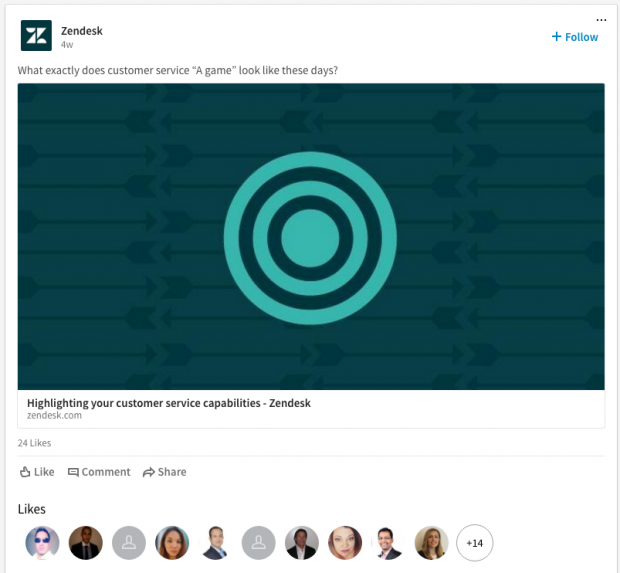For a time, cross-posting seemed the solution—offering a quick and easy way to share across multiple channels at once. But cross-promoting has been catching attention lately for its strategic prowess.
In this post, we’ll take a look at the differences between these two tactics and explain why cross-promoting is ultimately better. Yes, we said it—we’re putting our chips in the cross-promoting basket. Here’s why.
Bonus: Get the step-by-step social media strategy guide with pro tips on how to grow your social media presence with Hootsuite.
Cross-posting vs. cross-promotion: what’s the difference?
Cross-posting
Cross-posting is the act of posting the same message across multiple social media channels for a single piece of content.
So, say you have an article to promote. With the cross-posting approach you would publish the link with the exact same headline (and media file if there is one) across Twitter, Facebook, LinkedIn, etc.
For busy social media marketers cross-posting certainly has its allure—it’s easy and can save you loads of time when using a bulk scheduler. But cross-posting on social media also has its limitations—especially where channel compatibility is concerned.
Take, for example, Instagram’s feature that allows for auto-posting on Twitter. On the surface, auto-posting seems like a great timesaver—enabling you to update both channels simultaneously.
Dig a bit deeper though, and you’ll see this approach has its drawbacks due to compatibility glitches between the two platforms.
Sharing images on Twitter via Instagram used to be a simple affair—allowing seamless photo sharing from Instaland to the Twittersphere. Times were simple, life was good. That is until Instagram went and dumped Twitter (and broke all our hearts in the process).
Technically, auto-posting is still possible, but it ain’t pretty. Where once there were lovely images featured, auto-posted tweets now convert those images into links (that often appear cut off).
That’s right, a timeline filled with imageless tweets and unsightly links.
There are workarounds through third-party apps like IFTTT, but remember, the more tools you use, the longer it’ll take you to post—and wasn’t time saving the whole draw to cross-posting in the first place?
Cross-promoting
Cross-promoting, on the other hand, is content promotion through the creation of unique messages for each social media channel. While cross-promoting takes a bit longer to execute than cross-posting, you’ll likely have more success connecting with each platform’s unique user base.
Here’s a great example of cross-promoting in action from customer-service gurus Zendesk. Here we see how their team creates unique captions to individually suit their Twitter and LinkedIn audiences while pointing towards the same piece of content.
View image on Twitter

Follow
 Zendesk
Zendesk ✔@Zendesk
Rate how well your organization is aligned on key #custserv strategies with @Forrester's self-assessment tools. http://zdsk.co/2o6Y1Nv
7:57 PM - 6 Apr 2017
33 Retweets
22 likes

And here’s another example from app stars Zapier showing how they tailor their captions to specifically target audiences on Twitter and Facebook.
View image on Twitter

Follow
 Zapier
Zapier ✔@zapier
Did you know there are 4 different types of content calendars? Learn how to choose the best one for your team. http://zpr.io/P8KvM
10:01 PM - 13 Apr 2017
Retweets
22 likes
Benefits of cross-promotion on social media
Allows you to speak the language of each platform
Imagine showing up to a party where everyone appears to be speaking Spanish. Now imagine trying to tell a story in Japanese. Chances are you’d lose your fellow party-goers’ interest pretty fast.
The same goes when posting captions that don’t suit the personality of the network. You wouldn’t want to share a serious, text-heavy message on a highly visual platform like Instagram, for example.
With a cross-promotion approach you can keep your content on the mark by tailoring your message to the tone of each of your networks.
Will help increase the reach of your content
Sure your brand is publishing remarkable content, but what good is it if it’s not reaching the audience?
Simple cross-promotion techniques—like adding social tabs to Facebook (more on this in the next section)—can help you increase the reach of your content by making it easier for people to find one social network from another.
7 best practices for cross-promotion
1. A strong headline or message is key to grabbing people’s attention
Everyone knows the importance of the headline or social media message when it comes to getting clicks and shares. At the same time, people seem to forget that finding the right headline takes time.
Don’t fall back on click-bait formats you think will draw clicks. You need to strike a balance between being clear, and being emotionally evocative. The worst thing you can do is get someone to click on your message and send them to content that doesn’t deliver.
Make sure you take the time to brainstorm a few variations of the copy. Once you’ve established multiple good options, you can then test your messaging. Try pushing the same content with different messages and track what performs. Get to know what kinds of messaging work best with your audience, but never stop testing.
2. Make the most of your content by sharing to relevant channels
Not all content needs to be shared everywhere. Some content pieces will be better suited for specific networks. For example, a job posting will likely be of interest to your LinkedIn followers, but probably not to your Instagram fans.
3. Optimize content for each network
Embedded within each social media network are unspoken rules and expectations for content sharing. Content that’s created with these expectations in mind will perform much better.
Before posting your content, be sure to adjust your captions to suit the posting structure and rules of each network, like Twitter’s latest character limits. Where Twitter’s character limit dictates that text is kept punchy and directive, longer-form or more narrative-based captions could work better on personal relationship networks like Facebook.
Also be sure to avoid sharing network specific items on the wrong network—like tagging someone’s Twitter handle with an @mention on Facebook post.
4. Use UTM parameters to track content shared on different networks
Any social marketer knows, proving ROI is key to getting the rest of your organization to buy into the strategy.
To find out how well your links are performing across each channel, we suggest setting up UTM parameters for your content. UTMs make it possible to check the performance of your content—by network—in Google Analytics. Best of all, you don’t need to be a programmer to get started.
For more on this, check out our post, How to Use UTM Parameters to Track Social Media Success.
5. Stagger your social media posts
You don’t need to fire off all your posts across networks at the same time. In fact, it’s a good idea to stagger them according to the optimal posting times for each network.
Keep your social media publishing to a schedule. A social media management tool, like Hootsuite, allows you to schedule messages in advance so you’re not a slave to your calendar.
Scheduling messages ensures you’re posting at regular intervals rather than in bursts. Once people learn your schedule, they’ll start checking in when they can expect new content from you, building a certain degree of loyalty. This in turn can increase your click-through and engagement.
6. Add social tabs on your Facebook Page
You can further boost the connection between your social media channels by adding social tabs to your Facebook Page. Adding tabs can be done through the use of third-party apps (like powr.io or Woobox). You can also manually add Instagram directly through Facebook by following these quick steps.
7. Have a clear call-to-action
Your followers have seen your message, now what? Social media serves to support broader business goals, so your messages should ultimately be tied to a larger purpose beyond being seen or liked.
With that in mind, end your social posts with a strong call-to-action. Examples of good social media CTAs include:
Offering up more information on the topic in a blog post or resource
Encouraging them to sign up for a free trial of your product
Asking them to use a special social media code for a discount in store
Offering the potential of a prize for a specific action, like following and sharing
At the end of the day, the occasional use of cross-posting won’t kill your social media efforts. But to get the most out of your content, cross-promotion is definitely the way to go.
When getting started, use a social media calendar to help visualize your cross-promotion shares. You can find an easy calendar template on our blog.
No comments:
Post a Comment